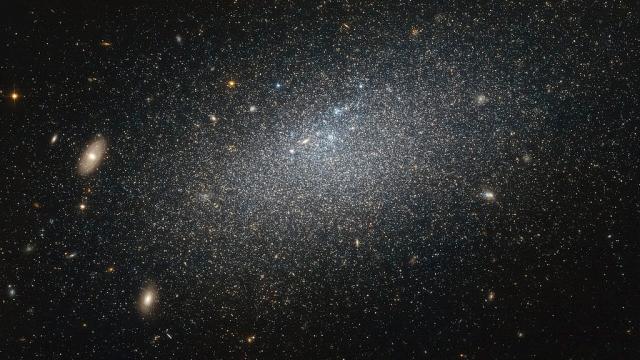There are few easier ways to get people to read your website than to scare them. That’s how we ended up with the media frenzy guilty ourselves.
Our universe had a beginning – the Big Bang. But we’d all like to know what the end would be like. Perhaps it will collapse in a big crunch, or keep expanding onwards forever. But since scientists discovered the Higgs boson particle back in 2012, some have wondered whether something stranger might happen.
A theoretical physics paper recently came out in the journal Physical Review D that really did foretell the universe’s end. Here’s a rather upsetting snippet:
“Since the lifetime [of the Standard Model of particle physics] is finite and the Universe infinite, there is likely a bubble of true vacuum already out there, far away. It is sobering to envision this bubble, with its wall of negative energy, barreling towards us at the speed of light. It seems the long-term future of our Universe is not going to be slow freezing due to cosmic acceleration but an abrupt collision with one of these bubble walls.”
That paper then predicts that the universe’s lifetime would be between 1088 and 10241 years, but probably probably around 10139 years. That’s 10,000,000,000,000,000,000,000,000,000,000,000,000,000,000,000,000,000,000,000,000,000,000,000,000,000,000,000,000,000,000,000,000,000,000,000,000,000,000,000,000,000,000,000,000,000,000 years.
This is not something you should worry about. At all. Despite recent headlines in Newsweek, Business Insider, the Daily Mail, and others.
Here’s what the paper’s actually saying. The universe is made from teeny particles. The rules that govern those particles are called the Standard Model of physics. A few of those particles called the W+, the W-, and the Z, have mass, but several decades ago physicists thought they shouldn’t. They solved that problem with a theoretical particle (and corresponding field) called the Higgs boson.
CERN scientists finally confirmed the existence of the Higgs boson back in 2012 by slamming other particles together at the Large Hadron Collider in Switzerland. Many theoretical physicists were interested in the Higgs’ mass, because alongside another particle called the top quark, they could be used to determine whether the vacuum of the universe was “metastable” or “stable.”
Think of the vacuum of the universe (the nothingness) as a surface upon which all of the laws of physics happen. If the universe is stable, there’s nothing below the surface — it’s the true bottom. If the universe is metastable, then perhaps there’s a true bottom beneath that floor. The idea is that maybe somewhere in our vast cosmos, the floor might break. That effect would ripple through the entire universe at the speed of light as the fake floor falls out to the real one.
The laws of physics would no longer work as we expect, since there’s now a new definition to what a “vacuum” means. Perhaps nothing would be able to exist in such a vacuum.
The team of Harvard physicists were interested in the lifetime of the metastable Standard Model for the same philosophical reasons that everyone has pondered the end. And the number they got, 10139, is actually quite satisfying.
“I think people don’t have a sense as to how big these numbers are,” study author and physicist Matthew Schwartz from Harvard told Gizmodo. “It’s such an enormous out of time. But they think 10139 years is 139.”
The universe is around 10 billion, or 1010 years old. 10139 is a completely unfathomable number of years. If you could imagine the entire length of the universe from the Big Bang to now as a single day on Earth, 10139 years would still be… far longer than the current age of the universe. It’s more than the amount of time it would take to count every atom in the universe, if you had to wait from the Big Bang until now in between counting each atom. That number of years eludes any rational attempt to understand it (Which is probably why it sounds so close – our heads just short circuit and say, threat!!!). It is forever.
And here’s the other thing: Physicists still don’t know for sure whether we live in that metastable universe or not. It looks like we do, based on current measurements, but further refining of the Higgs’ and top quark’s masses might reveal the first measurements were slightly off and we actually live in a stable universe. Maybe our floor is the real floor.
There are good reasons to study these things, said Schwartz. If their calculations had revealed that the Standard Model could only last for a million years, then there would have to be some other physics, perhaps new particles explaining why we were still here. But Schwartz and his team’s calculations imply that the Standard Model could last just fine without anything else, even if we did live in this metastable state. It’s also different from the conventional story, that eventually everything stops moving.
You should not worry about vacuum instabilities causing the universe to end. If you’re worried about the fate of humanity, you should worry about nukes, climate change, antibiotic-resistant pathogens, food insecurity, or clean water. The universe will be just fine.
